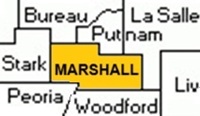
[Page 75]
Roberts Point was the name of a torn that was planned on paper. Where else
would be a logical place but the Carl Schulz farm which was formerly owned
by Livingston Roberts?
Livingston Roberts was one of the first settlers in Marshall County coming
in 1828. He followed the teaming business; making five or six trips to
Chicago. The return trip brought loads of merchandise for the new
settlement.
Evidently it was on one of these trips that the following happened to his
wife who had remained at home. An Indian came to the house and asked for
food. Mrs. Roberts told him he must wash his feet before eating. As he was
doing this, she killed him with an ax. Then she hid the body. Other Indians
came looking for him but she claimed he hadn't been there. This took place
in the old stone house which was the Roberts' first home. This 20 foot by 26
foot home was built using the stones from the creek. It was heated by a huge
fireplace and the wooden windows swinging outwards were the source of the
fresh air that was needed.
Mr. Roberts built the brick home in l841. The bricks were kilned a short
distance away where red clay was available. The walls are solid brick and
the thickest one is eighteen inches thick. Formerly there were six
fireplaces but all have been sealed shut. The mantel from one fireplace is
in the kitchen. There is a spiral gooseneck staircase in the hall and also a
rose colored window. The front door is pictured in Betty Madden 's book,
Art, Crafts and Architecture in Early Illinois, as an entrance in a former
inn near Wenona. (Varna didn't exist at that time.)
[Page 76]
This house was called “Halfway House" as it was half-way between Springfield
and Chicago. This was a stagecoach stop and people would stay overnight. The
three-story barn had a lighted lantern in the cupola each night to guide
travelers to the inn. Two or three barns have been rebuilt over the lower
story because of fire. The remains of the lower story still stands. The
stagecoach with four horses could drive into the barn and turn around there.
Mr. Roberts was a hospitable man and everyone was welcome. The house was a
well-known stopping place for travelers and a noted landmark. Abraham
Lincoln slept here many times and probably many more famous people.
The Roberts were friends of slaves and so the place was also part of the
Underground Railway. The slaves were kept in the stone house during the day
and they traveled at night.
The present owners are Carl and Tena Schulz. Carl was bom in this house, and
has never resided any other place. The home is located on Route 89 just
north of Varna, Illinois.
Mrs. Tena Schulz
[Page 77]
One of the best known landmarks in Marshall County still standing is this
old homestead built by George and Penelope Shaw west of Varna. It stands as
strong and able to withstand the elements as when the pioneering family
built it. Built of handmade brick its walls are two feet thick and there are
no windows on either end. Great walnut beams felled from the forest
surrounding the home support the two story residence. There are four large
rooms each with its own fireplace and between the two spacious rooms
downstairs and their counterparts upstairs runs a large center hallway. The
woodwork in the home is walnut, much of it hand polished by the three girls
and three boys born to that first family.
George Shaw's mother was a cousin of George Washington. His father had gone
to school with President James Buchanan. George and Penelope came by canal
boat and stagecoach in 1829. He brought with his young bride her Negro mammy
who begged not to be left behind although he had freed his slaves before
they left Kentucky. The mammy's grave was also in the family cemetery at
Shaw's Point.
They chose a tract of government land inland from the Illinois River about
eight miles. The trees grew this far onto the prairie and jutted out into
the plain. It became known as Shaw's Point and a school carried that name
also. It was built when their children needed an education and remained
until consolidation left it vacant. Tom Shaw became a lawyer in Hennepin,
and Elizabeth married a German immigrant doctor, Henry Tesmer, They built
the beautiful, great house on the side of the hill in Sparland. Hal Shaw had
gone to fight in the Civil War and was permanently disabled, but Tom carried
on where George Shaw left off. He married and settled along the Illinois
River and contributed much as Judge Shaw in one of the three Circuit Courts
in the state, later going to State Legislature.
After generations in the Shaw's name, the house was acquired in 1936 by the
O'Hern family of Peoria. The Sherman V. Carlsons of Varna lived there 26
years. Now it is the dwelling of the Richard Colesons.
The house itself has changed only slightly with the years. A room was added
at the back of the house, the large brick fireplace removed, the walnut
woodwork downstairs painted instead of painstakingly polished by six pair of
small hands. But the brick walls stand as strong as the day they were laid …
a monument to George and Penelope Shaw.
| Bureau Putnam La Salle | |||
| Stark |
 |
||
| Peoria | Woodford | ||

